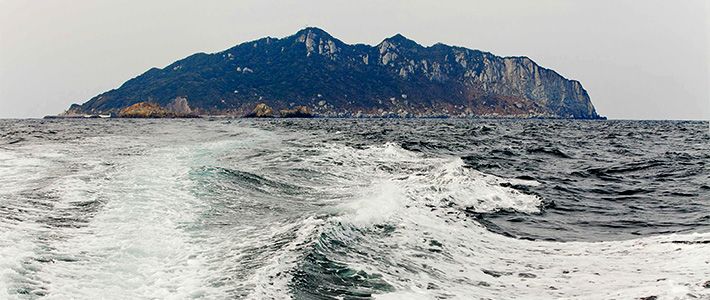
Sacred Island Selected for UNESCO List: An Overview of World Heritage Sites in Japan
Culture- English
- 日本語
- 简体字
- 繁體字
- Français
- Español
- العربية
- Русский
An Island of Ancient Rituals
On July 9, 2017, the World Heritage Committee of UNESCO announced the official registration of the Sacred Island of Okinoshima and Associated Sites in the Munakata Region on its World Heritage list.
Okinoshima is located some 60 kilometers off the coast of Fukuoka Prefecture in the Genkai Sea. From the fourth to the ninth century AD, large-scale rituals were performed on the island to pray for successful trade and safe voyages for ships plying the seas among Japan, Korea, and China. Around 80,000 offerings have been uncovered on Okinoshima, including gold rings from the Korean peninsula and fragments of a cut-glass bowl believed to have originated in Persia. All have been designated as national treasures. The entire island is considered sacred as part of the Munakata Taisha shrine on the mainland.
There are numerous taboos associated with the island. Women are not allowed to set foot there at all, and there are restrictions on visits by men, including a requirement to perform ablutions in the sea before coming on land.
Japan now has 21 World Heritage sites, including its four World Natural Heritage sites.
The Convention Concerning the Protection of the World Cultural and Natural Heritage (“the World Heritage Convention”), adopted at the 1972 General Conference of UNESCO, called for a list to be created of natural and cultural sites of “outstanding universal value.”
In December 1993, Japan’s first World Cultural Heritage sites were registered: the Buddhist Monuments in the Hōryūji Temple area (Nara Prefecture) and Himeji-jō Castle (Hyōgo). The sixteenth such site was registered in 2016, with the recognition of the National Museum of Western Art in Tokyo as part of The Architectural Work of Le Corbusier, an Outstanding Contribution to the Modern Movement. The country’s first two World Natural Heritage sites were also recognized in December 1993: Yakushima (Kagoshima) and Shirakami-Sanchi (Aomori and Akita). These were followed by Shiretoko (Hokkaidō) and the Ogasawara Islands (Tokyo), bringing the total number of sites to four.
As of June 2017, there are 1,052 World Heritage sites in the globe (814 World Cultural sites, 203 World Natural sites, and 35 mixed properties); a total of 193 countries have signed the “World Heritage Convention.”

| World Heritage Sites in Japan | Year listed |
|---|---|
| World Cultural Heritage Sites (Prefecture) | |
| Buddhist Monuments in the Hōryūji Temple Area (Nara) | December 1993 |
| Himeji-jō Castle (Hyōgo) | December 1993 |
| Historic Monuments of Ancient Kyoto (Kyoto and Shiga) | December 1994 |
| The Historic Villages of Shirakawa-gō and Gokayama (Gifu and Toyama) | December 1995 |
| Hiroshima Peace Memorial (Hiroshima) | December 1996 |
| Itsukushima Shintō Shrine (Hiroshima) | December 1996 |
| The Historic Monuments of Ancient Nara (Nara) | December 1998 |
| The Shrines and Temples of Nikkō (Tochigi) | December 1999 |
| Gusuku Sites and Related Properties of the Kingdom of Ryūkyū (Okinawa) | December 2000 |
| Sacred Sites and Pilgrimage Routes in the Kii Mountain Range (Nara, Wakayama, and Mie) | July 2004 |
| Iwami Ginzan Silver Mine (Shimane) | June 2007 |
| Hiraizumi—Temples, Gardens, and Archaeological Sites (Iwate) | June 2011 |
| Fujisan—Sacred Place and Source of Artistic Inspiration (Yamanashi and Shizuoka) | June 2013 |
| Tomioka Silk Mill and Related Sites (Gunma) | June 2014 |
| Sites of Japan’s Meiji Industrial Revolution: Iron and Steel, Shipbuilding and Coal Mining (Fukuoka, Saga, Nagasaki, Kumamoto, Kagoshima, Yamaguchi, Iwate, and Shizuoka) | July 2015 |
| The Architectural Work of Le Corbusier, an Outstanding Contribution to the Modern Movement (National Museum of Western Art; Tokyo) | July 2016 |
| Sacred Island of Okinoshima and Associated Sites in the Munakata Region | July 2017 |
| Natural World Heritage Sites (Prefecture) | |
| Yakushima (Kagoshima) | December 1993 |
| Shirakami-Sanchi (Aomori and Akita) | December 1993 |
| Shiretoko (Hokkaidō) | July 2005 |
| Ogasawara Islands (Tokyo) | June 2011 |